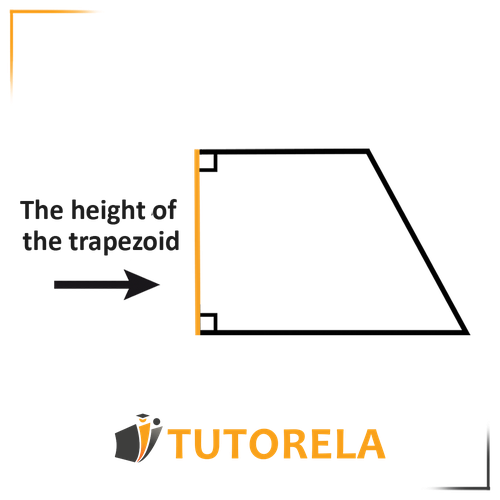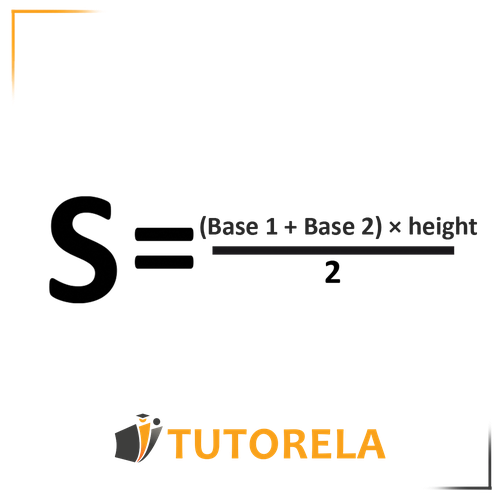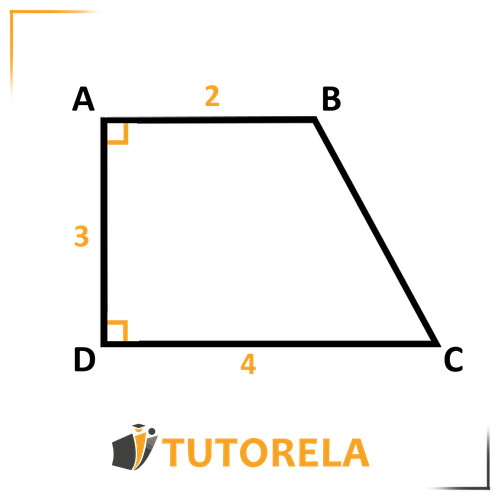In order to calculate the area of a right-angled trapezoid, we will use the following formula:

In order to calculate the area of a right-angled trapezoid, we will use the following formula:

The formula for calculating the area of a right-angled trapezoid is the same as every trapezoid's area - the sum of the bases times the height divided by 2.
The leg connecting the 2 right angles is also the height of the trapezoid!
Calculate the area of the trapezoid.
Before we begin, let's recall some properties of a right-angled trapezoid:
Properties of a right-angled trapezoid
Let's observe this in an illustration:

In order to calculate the area of a right-angled trapezoid, we will use the following formula:

The area of a right-angled trapezoid equals the sum of the bases multiplied by the height divided by 2.
Calculate the area of the trapezoid.
The trapezoid ABCD is shown below.
AB = 5 cm
DC = 9 cm
Height (h) = 7 cm
Calculate the area of the trapezoid.
Given the following trapezoid:
Calculate the area of the trapezoid ABCD.
Exercise:
Given the following trapezoid, calculate its area.

Given:
angle
angle
Solution:
We are told that there are 2 right angles in the trapezoid, therefore we are able to determine that it is a right-angled trapezoid.
In order to calculate the area of the trapezoid, we need to add the two bases, multiply by the height and divide the result by 2.
We know that in a right-angled trapezoid, the height is also the side connecting the two right angles, meaning .
Therefore:
We'll add the given bases and multiply by the height and divide this by . We obtain the following:
The area of the trapezoid is cm².
Additional Exercise
Here is the following right-angled trapezoid:

Given that:
Angle
Angle
Angle
What is the area of the trapezoid?
Solution:
To begin with, we need to look at all the given information and identify what type of trapezoid we are dealing with.
We are given one angle equal to degrees and other angles that together equal degrees.
We know that the sum of angles in a trapezoid equals degrees, therefore angle must equal degrees.
We can observe that in this trapezoid there are angles that equal degrees each, therefore it is a right-angled trapezoid.
To calculate the area of a right-angled trapezoid, we need to know the lengths of the bases and the height.
The height in a right-angled trapezoid is also the side connecting the two right angles - meaning side
The two bases are: and
According to the given information: and
Therefore
Let's calculate using the right-angled trapezoid area formula and we should obtain the following:
The area of the trapezoid is cm².
Additional Exercise:

Given that:
The area of the trapezoid is cm²
Angle
Angle
Angle
We know that the sum of bases is .
Determine the length of side and the size of side .
Solution:
We can confirm straightaway that this is a right-angled trapezoid given that it has angles equal to .
We are given the area of the trapezoid and we need to find the height -
If we recall the formula for finding the area of a right-angled trapezoid and substitute the sum of the bases and the given area of the trapezoid, we obtain the following:
We can clearly see that must be in order to obtain a true statement, therefore the height of the trapezoid equals .
The size of side needs to be completed to .
It is known that angle equals and therefore equals .
Given the following trapezoid:
Calculate the area of the trapezoid ABCD.
Given the following trapezoid:
Calculate the area of the trapezoid ABCD.
What is the area of the trapezoid in the diagram?
Calculate the area of the trapezoid.
We use the formula (base+base) multiplied by the height and divided by 2.
Note that we are only provided with one base and it is not possible to determine the size of the other base.
Therefore, the area cannot be calculated.
Cannot be calculated.
Calculate the area of the trapezoid.
To find the area of the trapezoid, we would ideally use the formula:
where and are the lengths of the two parallel sides and is the height. However, the given information is incomplete for these purposes.
The numbers provided (, , , and ) do not clearly designate which are the bases and what is the height. Without this information, the dimensions cannot be definitively identified, making it impossible to calculate the area accurately.
Thus, the problem, based on the given diagram and information, cannot be solved for the area of the trapezoid.
Therefore, the correct answer is: It cannot be calculated.
It cannot be calculated.
The trapezoid ABCD is shown below.
AB = 5 cm
DC = 9 cm
Height (h) = 7 cm
Calculate the area of the trapezoid.
The formula for the area of a trapezoid is:
We are given the following dimensions:
Substituting these values into the formula, we have:
First, add the lengths of the bases:
Now substitute back into the formula:
Calculate the multiplication:
Then multiply by the height:
Thus, the area of the trapezoid is 49 cm.
49 cm
Given the following trapezoid:
Calculate the area of the trapezoid ABCD.
To solve this problem, we follow these steps:
Now, let's work through these steps:
Step 1: We know from the problem that trapezoid ABCD has bases and , with a height of .
Step 2: The formula for the area of a trapezoid is:
Step 3: Plugging in the values:
Therefore, the area of the trapezoid ABCD is .
26
Given the following trapezoid:
Calculate the area of the trapezoid ABCD.
To solve this problem, we'll follow these steps:
Now, let us work through each step:
Step 1: The length of base is units, and the length of base is units.
Step 2: The height is units.
Step 3: Substitute the known values into the formula for the area of a trapezoid:
Step 4: Calculate the results:
Therefore, the area of trapezoid ABCD is square units.
40